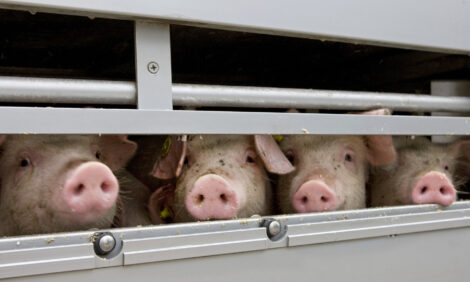



Market Preview: Pork Export Value Up 49.5 Per Cent in 2008
US - Weekly US Market Preview provided by Steve R. Meyer, Ph.D., Paragon Economics, Inc.December pork exports were surprisingly strong, given all of the doom and gloom we’ve heard, plus the sharp strengthening of the US dollar last fall. Figures 1 and 2 show exports from two slightly different views.


Figure 1 is carcass weight equivalent from USDA’s Economic Research Service (ERS). ERS converts Commerce Department/Foreign Agricultural Service data to carcass weight so it can be easily compared to production numbers here in the United States. On this basis, December 2008 shipments were 3.2 per cent higher than in December 2007 – an improvement from November’s 0.5 per cent year-on-year increase. December’s 312.3 million pounds of carcass weight exports brings the yearly total to 4.668 billion pounds, 48.6 per cent higher than in 2007. That amounts to 19.96 per cent of total US commercial pork production – definitely close enough to 20 per cent to use the rounded up number. Wow! The pork from one in every five pigs slaughtered last year went overseas. Unimaginable in 1995, when the United States was the world’s-largest pork “importing“ country.
Figure 2 shows annual exports on a product weight basis. These data come from the Commerce Department and the Foreign Agricultural Service. They are published in metric tons, the quantity units of international meat trade, but I have converted them to million pounds here. On this measure, exports grew by 49.4 per cent in 2008, with China/Hong Kong vaulting to the No. 2 ranking among US export markets. Shipments to Japan grew by 20.9 per cent last year – the largest annual growth rate since 2001 for our largest export market. Shipments to Mexico rebounded nicely (+51.6 per cent) after a difficult 2007. Finally, exports to Russia grew by 78 per cent last year, while exports to Canada continued their steady growth at +15.2 per cent.
Figure 3 is more important to the US pork business than either of the other two charts, since it is value that actually enhances the ability of packers to pay more for US hogs. The value of exports grew last year by 49.5 per cent -- slightly higher than the increase in export quantity, which means that export prices increased even while export quantities were exploding. That implies strong demand indeed.

Figure 3 also shows the true importance of a customer like Japan. They buy more and they buy higher-valued products. Canada remains the second largest US customer on a value basis, but both Mexico and China/Hong Kong closed the gap on Canada significantly in 2008.
In addition to the $4.116 billion of pork exports, the industry sold a record $559 million of pork variety meats abroad last year. That number was 102 per cent higher than in 2007, and was accomplished by selling 956.65 million pounds of variety meats, 94.8 per cent more than in 2007. The total value of pork and pork variety meat exports – $4.675 billion – equals $40.14/ head for each of the 116.458 million hogs slaughtered in the United States in 2008.
The string of record export years now stands at 17. Reaching 18 in 2009 will be very difficult, but the December export performance is encouraging since it occurred after the US dollar strengthened.
Hog Supplies on the Mark
A quick thought on hog supplies: They have been almost precisely what I expected coming out of the December Hogs and Pigs Report. Figure 4 shows the actual data for 2008 and 2009, and my forecasts for weekly slaughter for December 2008 through 2009. Note that the actual numbers have been very close to the forecasts, deviating only 0.5 per cent since 1 December. That’s good enough for me!

Does that mean that the rest of the December report – including the September-November pig crop that was pegged at 6 per cent lower than last year – is accurate? Not really. But it also doesn’t call that report into question. The more I hear about empty finishing barns in Iowa and Minnesota, the more I think my projected slaughter levels of just over 1.9 million per week in May and June are pretty solid.
Just how aggressive packers will be in chasing those pigs remains to be seen. They have had miserable margins over the past three months and have run inverted meat margins (i.e. the hog price has been higher than the cutout value) for six out of seven weeks this year. So, things need to improve on the product side to get hog prices significantly higher. Will the spring bring a normal surge of demand? I think so. But I’ve never had to make that call with an economy like this and I don’t think anyone yet knows how to factor it in to meat demand.









